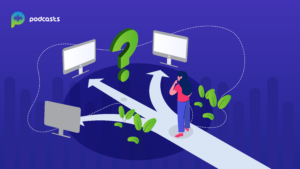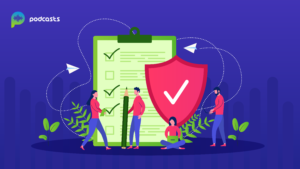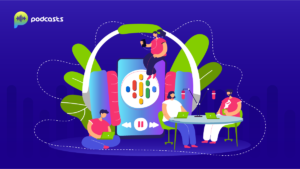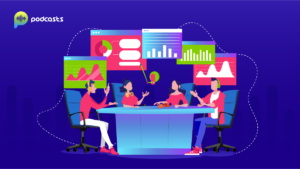If you are thinking of starting a podcast, whether it be for a fun hobby or if you are hoping to turn your podcast into your main source of income you’ll need to factor many variables to create a successful podcast.
You need to think through what platform you want to use to host your feed, whether you want to go live or do a recording and then publish it at a later time. You need to learn how to attract listeners and figure out what type of format you want to use.
This article will teach you how to format your podcast, get you more listeners, and make your podcast stand out among the thousands of others that are out there.
Choosing a Format that Best Suits You
Podcasts are very in and popular right now. They are the perfect thing to turn on and listen too during the morning and afternoon commute, they are fun to listen too and they are informative. Their popularity means that there is plenty of room for you to come in and make a great name for yourself with your podcast, but in order to do this, you need to pick a format and stick with it. There are six main types of podcasts and learning about them will help you decide which format is best suited for your own personal style. The podcast formats include interviews, conversational, educational, only you talking about a subject, and fiction and non-fiction storytelling.
It is important to pick one of these formats and stick with it so that your audience will know exactly what to expect when they tune in to the episodes that you put out each day or each week depending on how often you choose to release new episodes. If you put out a podcast one week that is educational, then you tell a fictional story the next week, but do an interview a week after that, your audience will get confused as to what your purpose is and it will be harder for you to gather a bigger following.
Your goal when picking a format is to pick one that your audience can hear and describe to other people when they are trying to tell them about your show. You want them to be able to easily describe you so that they can recommend your show. Sticking with one of the above-mentioned formats will also guarantee that you can more easily put out content as they can feed off of each other show after show.
Choose a Niche and Stick to It
Just as you need a niche if you are a blogger, it is important for podcasters to find a niche that suits their personalities and allows them to talk about their passions. On top of that, you also need to fill a need; people can talk about any topic all day long and not a single person will be interested in listening to them. It is important to pick a niche that people want to learn about and can’t find anywhere else. When picking your niche out, think through what will bring in more listeners to your podcast, and pick one that can make you money over time. Think about what you are an expert in and how your expertise can help and teach other people when they listen to your podcast.
Choosing a Standard Guest Show or a Topic Introduction?
The next thing you need to consider is whether you want to have a guest join you on your show every week to talk with you about a chosen topic, or if you want to pick a topic and discuss it on your own.
Many podcasters choose to invite a guest on their show every week. Whether this guest is an expert in the field in which they are discussing or they are a friend of yours in which you can converse with on a chosen topic easily. Having a guest on the show is an often preferred method because it helps to keep your conversation flowing easily and keeps your podcast moving in the right direction. Having a guest to talk and converse back and forth with is also preferred because it keeps your topic interesting which in turn keeps your current audience interested and helps to attract more audience members to you.
Topic introductions, on the other hand, are also popular podcast methods. This is where you will pick a topic and talk about it for yourself. Typically, more experienced podcasters are the ones who do this as it takes a lot to be able to pick an interesting topic and keep it rolling throughout the entire podcast without sounding as though you are rambling so you can hold the attention of your listeners.
Podcast Quips vs. Q&A Sessions
Whether you decide to do quips in your podcast or have a full-on question and answer session is totally dependant on what type of format you picked out for your podcast. A quip is typically much more fun and allows you to interact with the audience making them laugh and engage back with your witty remarks or funny observations and responses. A quip is almost like a funny jab or joke directed at member(s) of your audience. Having a quip on your podcast is definitely a different choice and can really make you stand out and bring more people to your podcast if you do it correctly. When people know that your podcast is going to be fun and provide them with some humor, they are highly likely to tune in and listen!
If funny jokes just are not your thing, then perhaps a question and answer session would be better suited for your style. When you do this type of format, you will have people either write in with their questions on a topic that you give them ahead of time and you will answer their questions the next time your podcast comes out, or you can go live and introduce the topic then have them ask you questions that you will answer in real-time. If you choose this format you need to be well versed on the topic so that you can answer any questions your audience has fully and in a way that keeps your audience engaged.
Have a Podcast Call to Action
The main goal of your podcast is to draw as many people in as you possibly can so that you can grow your audience and therefore expand your platform. One way to do this aside from having a great topic that people want to listen too is by compelling your audience that is tuning in to do a call to action. A great way to call people to action on your podcast is to ask them to subscribe to your channel.
You may think that the number of subscribers you have is not incredibly important, but if you want more views and exposure and targeted traffic to your podcast channel, then you need more subscribers which will help increase your visibility. In essence, a fan of your podcast who becomes a subscriber is more likely to like and share your podcasts with other people which will help build up your subscriber base. This, in turn, creates a powerful online community and will eventually be the difference in having a podcast as a hobby and a podcast that makes you money.
Make Sure to Recap Previous Episodes
In case some of your regular listeners missed out on an episode, it is important to help fill in the gaps of what they missed so that they can be caught up with the current episode. You also want to recap the previous episodes for people who might be coming in and listening to your podcast for the first time ever. Spending three to five minutes at the very beginning of your podcast recapping the previous one will help everyone get caught up and ready for what you have ready for them on this one.
Final Tips for Creating a Successful Podcast
Each format option in a podcast has a lot of room to play and get creative with it. Once you pick which format you want, you can really use your own unique voice and put your own spin to it to make it your own. There is a lot of competition among podcasts to become successful, so it is important to stand out by giving your audience a reason to listen to your show above others. It is also important to think not only about what your strengths are but finds a format that fits your personal and professional goals, think about your strengths, what kind of podcast you personally like to listen too, and what your other abilities are.
Creating a successful podcast episode layout can be a daunting task, but it can also be fun and teach you a lot about yourself that you never knew before. Dare to step out of the box and show the world what you have to offer.












